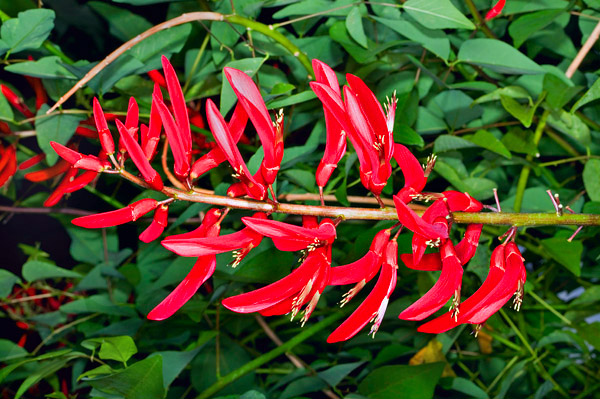Family : Fabaceae

Text © Pietro Puccio

English translation by Mario Beltramini

Erythrina x bidwillii is an horticultural hybrid of Erythrina herbacea and Erythrina crista-galli © G. Mazza
The name of the genus comes from the Greek “erythros” = red, with reference to the prevailing colour of the flowers of the species belonging to the genus; the hybrid is honoured to the English botanist John Carne Bidwill (1815-1853).
Common names: bidwill’s coral tree, fireman’s cap, Indian coral tree, shrub coral tree (English); arbre corail de Bidwell (French); árbol coral (Spanish); Korallenbaum (German).
The Erythrina × bidwillii Lindl. (1847) is a perennial hybrid, deciduous or semi-deciduous, with a look usually intermediate between that of the parents; in particular, the leaves have shape and colours closer to those of Erythrina herbacea, whilst the inflorescences are close to those of Erythrina crista-galli.
It appears as a shrub or a small tree, in the milder climates, 3-4 m tall, much ramified with robust, thorny, 2 m and even more long, curved branches. The leaves are alternate, odd-pinnate, composed by three ovate or elliptic leaflets with sharp apex, 4-10 cm long; the inflorescences, produced from May to November in axillar and terminal racemes, are 30-90 cm long with bright red, about 5 cm long, flowers. Sterile hybrid, it reproduces by herbaceous cutting in spring and semi-woody in summer.
It is a plant of great ornamental and landscape value, suitable for being cultivated, in full sun, in the tropical, subtropical and temperate climate zones, in particular those characterized by marked seasonality as it can resist, once well rooted, to long period of dryness; it can be therefore, utilized in desert gardens.
It may bear temperatures down to -6 °C, whilst the foot of the plant, with a good mulching, may resist to -10 °C. In such case, the plant will assume the appearance of a low bush and the flowering will begin between June and July. It is not particular for what the soil is concerned, provided the same is well draining; the addition of organic substance is useful. It is good to prune the woody stems of the inflorescences once withered and drastically the plant by the end of winter in order to maintain a compact look.
Due to the presence of thorns, it is wise to avoid placing it in passageways and, due to the superficial rooting apparatus, close to sidewalks and foundations. It may be cultivated in pot with frequent pruning in order to stimulate the blooming and to keep reduced its size. All parts of the plant do contain potentially toxic substances.
Synonyms: Erythrina corallodendron T.C. Huang & H. Ohashi (1977).
→ To appreciate the biodiversity within the family of FABACEAE please click here.
